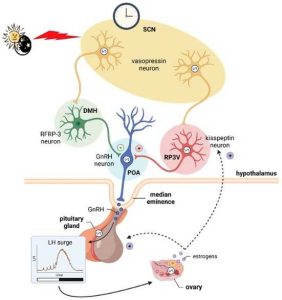Effect of disrupted light-dark cycles (shift work and light at night)
Etienne Challet, Valerie Simonneaux, Stéphanie Dumont, Nathalie Jeandidier, Thibault Bahougne, Marine Simonneaux, Emma Grosjean

Presentation
 In this project, we are assess the impact of disrupted ligh/dark cycles on metabolic and reproductive functions specifically in female rodents. This project involves both the conventional nocturnal mice in which the neuroendocrine mechanisms regulating daily reproduction and metabolism are well known, and the diurnal grass rats (Arvicanthis) as a novel model of human pathophysiology.
In this project, we are assess the impact of disrupted ligh/dark cycles on metabolic and reproductive functions specifically in female rodents. This project involves both the conventional nocturnal mice in which the neuroendocrine mechanisms regulating daily reproduction and metabolism are well known, and the diurnal grass rats (Arvicanthis) as a novel model of human pathophysiology.
We have already shown that male diurnal grass rats exposed to only 3 months of weekly jet-lag display glucose intolerance and telomere attrition, a cellular hallmark of biological aging, and diminished hepatic expression of SIRT1, an NAD+-dependent deacetylase that modulates the molecular clock and protects telomeres from shortening (Grosbellet et al. FASEB J, 2015). Here our goal is to separate the direct impact of light at night from the impact of the desynchronization of the circadian system, and to understand how circadian disturbances can accelerate cellular aging and be diabetogenic in female. First we will perform functional tests for metabolism and reproduction in jet-lagged versus light at night-exposed female diurnal grass rats. Then, internal circadian disorganisation will be assessed by analysis of daily patterns of clock gene expression on hypothalamic and peripheral samples. In addition, expression of specific metabolic and reproductive genes will be analysed. We will also investigate intra-cellular pathways involved in aging within the liver, pancreas and laser-microdissected SCN. Depending on which signaliiing pathways are most affected, and in which structure, we will counteract cellular aging by targeted pharmacological treatments. We will also focus on impaired glucose metabolism (glucose intolerance) in jet-lagged grass rats by determining whether insulin responses are increased or decreased during glucose tolerance test to dissociate insulin resistance or deficiency. This analysis of functional and molecular alterations should help to understand the pathophysiological mechanisms of jet-lag in a diurnal species, and to propose a hypothetical framework explaining diabetogenic effects of chronic jet-lag.
 Human fertility troubles is becoming an important society issue. We recently demonstrated that exposure to chronic jet-lag abolishes the LH surge and reduces fertility in female mice. As an increasing number of women work in shifted schedule, it is important to better understand the mechanisms involved in order to find strategies to limit the negative reproductive consequences of shiftwork. The objectives of this project are:
Human fertility troubles is becoming an important society issue. We recently demonstrated that exposure to chronic jet-lag abolishes the LH surge and reduces fertility in female mice. As an increasing number of women work in shifted schedule, it is important to better understand the mechanisms involved in order to find strategies to limit the negative reproductive consequences of shiftwork. The objectives of this project are:
- to analyse how daily and estral rhythms of the hypothalamo-pituitary-ovarian axis are altered under chronic shift;
- to assess whether chonic shift exposure alters female fertility and offspring development;
- to establish protocols to restore this fertility; and
- in collaboration with the endocrinology department of the Strasbourg Hospitals (Idex Unistra, SFD fundings), to determine whether women working in shiftwork also show alterations in their reproductive and metabolic indexes.

Etienne Challet

Valérie Simonneaux

Stéphanie Dumont

Nathalie Jeandidier

Thibault Bahougne

Valérie Simonneaux

Emma Grosjean
Bahougne T, Kretz M, Angelopoulou E, Jeandidier N, Simonneaux V. Impact of Circadian Disruption on Female Mice Reproductive Function. Endocrinology 2020; 161(4):bqaa028. doi: 10.1210/endocr/ bqaa028. PMID: 32100021
Henningsen JB, Ancel C, Mikkelsen JD, Gauer F, Simonneaux V. Roles of RFRP-3 in the Daily and Seasonal Regulation of Reproductive Activity in Female Syrian Hamsters. Endocrinology 2017 ;158(3):652-663. doi: 10.1210/en.2016-1689. PMID: 27983867.
Simonneaux V, Bahougne T. A Multi-Oscillatory Circadian System Times Female Reproduction. Front Endocrinol (Lausanne) 2015 ;6:157. doi: 10.3389/fendo.2015.00157
Chassard D, Bur I, Poirel VJ, Mendoza J, Simonneaux V. Evidence for a Putative Circadian Kiss-Clock in the Hypothalamic AVPV in Female Mice. Endocrinology. 2015;156(8):2999-3011. doi: 10.1210/en.2014-1769.








